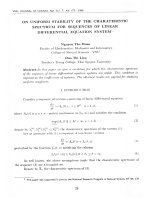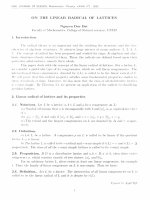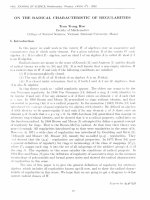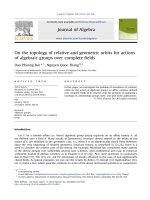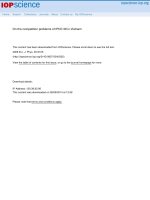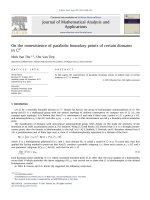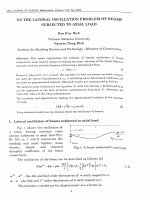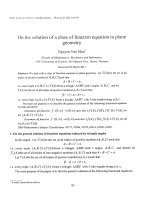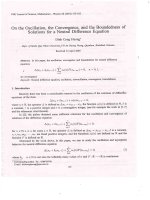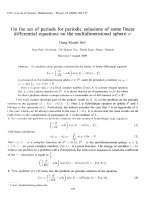DSpace at VNU: On the Effect of the Label Bias Problem in Part-Of-Speech Tagging
Bạn đang xem bản rút gọn của tài liệu. Xem và tải ngay bản đầy đủ của tài liệu tại đây (582.29 KB, 6 trang )
2013 IEEE RIVF International Conference on Computing & Communication Technologies Research, Innovation, and Vision for the Future (RIVF)
On the Effect of the Label Bias Problem in
Part-Of-Speech Tagging
Phuong Le-Hong
Xuan-Hieu Phan
The-Trung Tran
University of Science
Vietnam National University, Hanoi
University of Engineering and Technology
Vietnam National University, Hanoi
FPT University
FPT Corporation, Vietnam
Abstract—This paper investigates the effect of the label bias
problem of maximum entropy Markov models for part-ofspeech tagging, a typical sequence prediction task in natural
language processing. This problem has been underexploited and
underappreciated. The investigation reveals useful information
about the entropy of local transition probability distributions
of the tagging model which enables us to exploit and quantify
the label bias effect of part-of-speech tagging. Experiments on a
Vietnamese treebank and on a French treebank show a significant
effect of the label bias problem in both of the languages.
Index Terms—label bias problem, machine learning, MEMM,
CRF, part-of-speech tagging, Vietnamese, French, treebank
I. I NTRODUCTION
In the sequence prediction problem, we attempt to predict
elements of a sequence on the basis of the preceding elements. Many statistical sequence models have been developed for sequence prediction, for example hidden Markov
models (HMM) [1], [2], maximum entropy Markov models
(MEMMs) [3] or conditional random fields (CRFs) [4]. These
are all powerful probabilistic tools for modeling sequential
data and have been applied to many text-related tasks such
as part-of-speech tagging, named entity recognition, text segmentation and information extraction.
These typical models are all finite-state automata with
stochastic state transitions and observations. In addition, these
models all use the Markov property in that the decisions about
the state at a particular position in the sequence can depend
only on a small local structure. Without this property, the
inference of the models is intractable. Among them, MEMMs
are widely used in practice because of their efficiency and
accuracy. On the one hand, MEMMs are a discriminative
counterpart of HMMs which offers many advantages and
usually outperforms HMMs in a wide range of sequence
prediction tasks. On the other hand, MEMMs are much more
rapid than CRFs and HMMs in both of the training and the
decoding phases. In CRFs and HMMs we need to use some
version of the forward-backward algorithm in training. In contrast, in MEMMs, estimating the parameters of the transition
probability distributions can be done for each local model
in isolation. Although the prediction accuracy of MEMMs is
usually reported to be inferior than that of CRFs, the difference
is sometimes not significant; the two discriminative models
may be competitive in some tasks.
978-1-4799-1350-3/13/$31.00 ©2013 IEEE
The main drawback of MEMMs which makes their accuracy
inferior than CRFs is “the label bias problem”. This problem is
mainly due to the uselessness of the observation at a particular
position in predicting the most probable state at that position
of the sequence. Although this is a well-known problem in
the machine learning community, it has been underexploited
and underappreciated. To the best of our knowledge, we are
not aware of any study which investigates in detail the label
bias problem in sequence prediction in general and in part-ofspeech tagging in particular.
In this paper, we investigate the effect of the label bias
problem in part-of-speech tagging, a particular sequence prediction task in natural language processing. We show the
evidence that the entropy of transition probability distribution
of a local model in MEMMs is log-normally distributed. Based
on this observation, we propose a method for quantifying the
label bias effect which directly uses the entropy of transition
probability distribution. We find that half of the times that
the MEMMs for Vietnamese part-of-speech tagging does not
need the current word identity for predicting its tag but it can
achieve a ratio of about 68% of its maximal accuracy. This is
indeed show the significant effect of the label bias problem in
Vietnamese part-of-speech tagging. It is also confirmed by a
CRF model which shows a large improvement of accuracy
over MEMMs for part-of-speech tagging of Vietnamse. In
addition, we see that the label bias effect on French tagging
is also significant and slightly stronger than on Vietnamese
tagging.
The paper is structured as follows. Section II introduces
some preliminaries on MEMMs for sequential tagging and
its inherent label bias problem. Section III describes the
methodology for investigating and quantifying the label bias
effect in tagging. Section IV presents the evaluation results
and discussion. Finally, section V concludes the paper.
II. BACKGROUND
A. Tagging with MEMMs
Part-of-speech (POS) tagging is a typical sequence prediction task in natural language processing. In POS tagging we
are interested in building a model that reads text in some language and assigns parts of speech to each tokens, such as noun,
verb, adjective. In general, POS taggers in computational applications use more fine-grained POS tags like common noun
103
···
Yt−1
Yt+1
Yt
···
s1
b:ǫ
s0
Fig. 2.
or proper noun. In MEMM for POS tagging, we model the
conditional probability of a tag sequence y = (y1 , y2 , . . . , yT )
given a word sequence o = (o1 , o2 , . . . , oT ) as follows:
T
P (y | o) =
P (yt |y1 , . . . , yt−1 , o)
t=1
T
T
P (yt |yt−2 , yt−1 , o) ≈
≈
t=1
P (yt |yt−1 , o),
t=1
where the observations ot are words and yt are their corresponding tags. The first approximation of the conditional
probability is used in a second order MEMM while the
second approximation is used in a first order MEMM1 . Let
ht = o, t, yt−2 , yt−1 denote the tagging context at position
t. A MEMM can be considered a product of local models
which are chained together as shown in Figure 1 where an
uppercase bold character represents a random field which is a
collection of random variables.
Each local model of MEMM is defined by a maximum
entropy model (also called multinomial logistic regression
model), defined as
P (yt |ht ) =
exp(θ · f (ht , yt ))
,
s∈S exp(θ · f (ht , s))
(1)
where f (ht , s) ∈ RD is a real-valued feature vector, S is the
set of possible tags and θ ∈ RD is the parameter vector to
be estimated from training data. Note that we use the same
parameter vector for all local models in a MEMM. This form
of distribution corresponds to the maximum entropy probability distribution satisfying the constraint that the empirical
expectation for the feature is equal to its true expectation given
the model:
E(fj (h, t)) = E(fj (h, t)),
n:b`an
s3
n:b´an
s4
A local model of a MEMM at position t.
s2
b:ǫ
O
Fig. 1.
a` :ǫ
a´ :ǫ
s5
An example of the label bias problem
B. The Label Bias Problem
As mentioned in the previous section, the major shortcoming of MEMMs is that they potentially suffer from “the label
bias problem”. This problem is due to two possible sources.
The main source is that there are cases that a given observation
is not useful in predicting the next state of the model.
For example, Figure 2 represents a simple model which is
designed to discriminate between two Vietnamese words b`an
and b´an2 . Suppose that the observation sequence is b´an. In
the first step, both of the two transitions from the state s0 are
b, therefore the transition probability is divided equally likely
to the two out-going transitions. Next, the observation a´ is
given. Both of the states s1 and s4 have unique out-going
transition. The state s1 has seen this observation multiple
times and the state s4 has never seen it in the training data.
However, the state s4 transfers all of the probability mass
that it received to its only out-going transition since it does
not generate the observation but being conditioned on the
observation. Thus, if a state has a unique out-going transition,
the given observation is useless in predicting the next state of
the automaton. In general, a state whose transition probability
distribution has a small entropy does not make use of the
current observation in predicting the next state. In the example
above, both of the two paths from state s0 to state s3 have the
same probability regardless of the current observation. If an
observation is seen more than the other in the training data,
the priority will be given to it and its state sequence will be
chosen regardless of the current observation, which could lead
to a wrong prediction.
Another source of label bias is the use of previous tags in
training and testing. In training, the model always uses known
previous tags so they may decide a wrong tag at test time
when there is uncertainty in the previous tag.
∀j = 1, 2, . . . , D.
III. M ETHODOLOGY
The parameter θ ∈ RD can be estimated using iterative
scaling algorithms [5], [4], [6] or some more efficient gradientbased optimization algorithms like conjugate gradient or quasiNewton methods [7], [8], [9]. In the decoding phase, the
optimal tag sequence y for a given word sequence o can
be found using a Viterbi-like algorithm as the one used for
HMMs. A detail presentation of this model for POS tagging
can be found in [3].
1 To make the term P (y |y
t t−2 , yt−1 , o) meaningful for t ≤ 2, one may
pad the beginning of the sentence with a distinguished token marking the
beginning of sentence.
A. Entropy of Transition Probability Distribution
We propose a method for investigating the label bias
problem in sequence prediction which makes use directly
the transition probability distribution of each local model in
MEMMs. Consider the transition probability distribution (1)
of a local model given tagging context h:
P (y|h) =
exp(θ · f (h, y))
,
s∈S exp(θ · f (h, s))
∀y ∈ S.
2 In Vietnamese, b`
an means either table (noun) or to discuss (verb) and b´an
means either to sell (verb) or semi- (adjective), depending on context.
104
1.5
TABLE I
ACCURACY OF A
0.5
entropy
1.0
Feature templates
ot , yt−1 , ot−1
yt−1 , ot−1
MEMM
TAGGER
Accuracy
88.59%
36.43%
Algorithm 1: Compute P (·|ht ) using a set of feature
templates F
z ← 0;
for y ∈ S do
ut ← θ · featureVector(ht , y, F (t));
score(y) = exp(ut );
z ← z + score(y);
0.0
0.0
0.5
1.0
1.5
2.0
2.5
N = 11713 Bandwidth = 0.07465
Fig. 3.
FIRST ORDER
Estimated density of an empirical transition entropy distribution
for y ∈ S do
P (y|ht ) ← score(y)/z;
The entropy of a distribution P (·|h) is given by
E(h) = −
P (y|h) log P (y|h)
return P (·|ht );
(2)
y∈S
where P (x) log P (x) is understood to be zero whenever
P (x) = 0. This quantity can be seen as a random variable
which is a function depending on context. For short, we call
this quantity the transition entropy. In general, entropy is a
measure of the uncertainty or the average unpredictability in
a random variable [10]. In this problem, transition entropy
is a measure of the uncertainty of a transition probability
distribution. The smaller the transition entropy is, the greater
predictable the transition is.
We have seen in the previous section that the first source for
the label bias problem is due to a small entropy of transition
probability distribution at a state. Therefore, a natural question
to ask is whether the transition distribution entropy can be
statistically modeled so that its related properties can be drawn.
With this in mind, we first try to find an approximate probability distribution for the transition entropy. Figure 3 shows
the estimated density of the transition entropy distribution
computed on a sample of 100 sentences. The entropy density
looks similar on larger data sets.
An empirical study on the transition entropy reveals the
evidence that this random variable is distributed log-normally.3
This is conform to the fact that in statistical modelling, a
variable might be modeled as a log-normal distribution if
it can be thought of as the multiplicative product of many
independent positive random variables as observed in many
examples found in economics and finance.
In the following experiments, we characterize the effect
of the label bias problem in first order MEMMs using the
transition entropy information. In first order MEMMs, each
tagging context at position t is denoted by ht = o, t, yt−1
where o is the entire word sequence. In all sequence models,
the current word ot in this sequence is the most important
information to infer its tag yt given the context ht . The
current word is used to extract many useful features which
help predict its tag, including word form features such as
3 Due to space constraint, we do not present in detail the tests of lognormality here. This will be appended in an extended version of this paper.
the prefix, the suffix, the length or alphanumeric properties.
Table I shows the accuracy of a typical MEMM tagger which
is trained and tested on the Vietnamese Treebank corpus [11].
The parameters of the model are estimated using the limited
memory BFGS optimization method [8] with L2 regularization
technique. Notice that this first order tagger has a modest
accuracy in comparison with the result previously published
in [12], [13]. This is due to three reasons. First, we do not
focus here on improving the accuracy of the tagger but on
investigating the label bias problem of the tagging model.
We hence use a simple first order Markov model instead
of the second order model which has been comprehensively
demonstrated its superior. Second, we do not exploit the word
form features in tagging which are crucial when predicting the
tag of a word in general and of an out-of-vocabulary word in
particular. Third, we use the most simple decoding algorithm
– the greedy algorithm for tagging instead of a Viterbi-like
algorithm which obviously results in an inferior performance.
The above tagging results demonstrate the importance of
the identity of the current word in tagging. Without using the
current word, the the accuracy drops heavily from 88.59%
to 36.43%. Howerver, one might be surprised that we can
correctly guess the tag of a word given only its previous word
and its previous tag in more than one third of the times. At first
glance, one may think that the label bias problem could not
be significant in this task given this fact. However, we shall
prove that this intuition is wrong. To show this, we exploit
the transition entropy as follows: if the transition entropy of a
local model is less than a fixed threshold, we omit the identity
of a current word when predicting its tag, otherwise the word
identity is used.
Let F1 (t) denote the typical set of feature templates used
in each local models of first order MEMMs consisting of the
identity of current word, the tag of the previous word, and the
identity of the previous word, that is F1 (t) = {ot , yt−1 , ot−1 };
and let F2 (t) ≡ F1 (t) \ {ot } = {yt−1 , ot−1 }.
Suppose that the function featureVector(ht , y, F )
computes the feature vector using a template set F . According
105
TABLE II
ACCURACY OF THE MODIFIED MEMM ON THE V IETNAMESE TREEBANK
Algorithm 2: Compute P (·|ht )
P (·|ht ) ← P (·|ht , F1 (t));
E(ht ) ← entropy(P (·|ht ));
if E(ht ) < ǫ then
P (·|ht ) ← P (·|ht , F2 (t));
ǫ
0.01
0.02
0.03
0.04
0.05
0.06
0.10
0.20
return P (·|ht );
to the standard MEMMs, each local transition probability distribution P (y|ht ) is computed by the procedure prob(·|ht , F )
as shown in Algorithm 1.
Following the idea of exploiting the transition entropy,
the real distribution P (·|ht ) used in the decoding phase is
computed as in Algorithm 2, where entropy is a function
calculating the entropy of a transition distribution and ǫ is
a fixed threshold. The main idea is that if the entropy of a
tagging context is less than the threshold then the “biased”
feature template set F2 is used, otherwise the original feature
template set F1 is used when computing each local transition
probability distribution. If a context ht satisfies E(ht ) < ǫ, it
is called a biased context.
B. Conditional Random Fields
To overcome the label bias problem while reaping the
benefits of using discriminative model for labeling sequential
data, Lafferty et al. [4] introduced CRFs, a form of undirected
graphical model that defines a single log-linear distribution
over an entire label sequence given the observation sequence.
CRFs are designed to avoid the label bias problem of MEMMs
and other discriminative Markov models based on directed
graphical models. Therefore, a comparison of accuracy between CRFs and MEMMs in a specific sequence prediction
task would be useful to quantify the advantage of CRFs over
MEMMs and the performance gain may partially give an
empirical evidence about the effect of the label bias problem
on the task. In this section, we briefly introduce CRFs and
their use in sequence tagging.
In essence, in CRFs, one considers a global feature vector
F (o, y) defined as a sum of T local feature vectors defined
over the entire sequence:
T
F (o, y) =
f (ht , yt ),
(3)
t=1
The probability of the label sequence given an observation
sequence is modeled as
P (y | o) =
exp(θ · F (o, y))
.
s∈S T exp(θ · F (o, s))
(4)
This is a maximum entropy model but it is much bigger than
the local model of MEMMs in that the set of possible values
of S T is large if T is big and the normalizing constant is a
sum on this set.
Although this model has a high complexity, we can still use
a Viterbi-like decoding algorithm to find the best tag sequence
of a given observation sequence.
Percentage
7.43%
9.89%
13.38%
15.70%
17.89%
19.70%
25.39%
35.07%
Accuracy
82.29
78.41
76.36
73.99
72.88
71.32
67.92
62.80
ǫ
0.30
0.40
0.50
1.00
1.50
2.00
2.50
2.56
Percentage
43.52%
50.45%
56.22%
79.16%
92.40%
98.87%
100.0%
100.0%
Accuracy
58.72
55.92
53.10
43.43
38.28
36.45
36.43
36.43
Given an observation sequence o = (o1 , o2 , . . . , oT ), we
need to find y = (y1 , y2 , . . . , yT ) such that P (y | o) → max.
Since the normalizing constant does not depend on y, we have
arg max P (y | o) = arg max [θ · F (o, y)]
y∈S T
y∈S T
T
= arg max θ ·
y∈S T
f (ht , yt )
t=1
T
= arg max
y∈S T
θ · f (ht , yt ) .
t=1
For details of the linear chain CRFs model for sequence
prediction, see [4]. In the CRFs model, the parameters interact with each other on a global scope in order to give
the probability of the sequence via the global normalization
constant. As a result, all parts of the training data will affect the
parameters. This helps avoid the label bias problem exposed by
MEMMs. In order to quantify the label bias effect of MEMMs,
we implement a CRFs model for tagging and compare the
difference of accuracy between the two models.
IV. E VALUATION
In this section, we report the results of the experiments implementing the methodology presented in the previous section.
The experiments are carried out on a Vietnamese treebank and
a French treebank.
A. Results on a Vietnamese Treebank
The Vietnamese treebank containing 10, 165 manually
tagged sentences, of which 9, 665 sentences are used as
training set and 500 sentences are used as test set [11].
Table II shows the accuracy of the sparse MEMM which
is trained and tested on the treebank. In this table, ǫ is the
threshold of transition entropy used in Algorithm 2. The
second and fifth columns indicate the percentage of transition
entropy values that are less than ǫ in the test data. We use the
greedy decoding algorithm to predict tag sequences.
We see that when fixing the transition entropy threshold
ǫ = 0.4, half of the times that we do not need the current
word for tag prediction but we can achieve about 67.95%
of the maximal accuracy obtainable by the model (55.92%
over 82.29%. If ǫ = 0.1, 25% of the times that the model
can achieve 82.53% of the maximal accuracy without using
the current word (67.92% over 82.29%). Figure 4 presents
the dependence of the accuracy and the percentage of biased
contexts on threshold ǫ.
106
1.0
French
Vietnamese
0.6
0.4
0.0
0.0
0.2
0.2
0.4
accuracy
0.6
0.8
0.8
accuracy
percentage
0.0
0.5
1.0
1.5
2.0
2.5
0.0
epsilon
0.5
1.0
1.5
2.0
2.5
3.0
epsilon
Fig. 4. The dependence of the tagging accuracy and the percentage of biased
contexts on entropy threshold ǫ on a test set of the Vietnamese treebank
Fig. 6. Comparison of the label bias effect on French and Vietnamese partof-speech tagging
We then build a CRF tagging model which makes use
of the same feature template as that of MEMMs. The CRF
model is trained by the limited-memory BFGS optimization
algorithm [8] and L2 regularization technique with smooth
constant fixed at 1.0. The resulting CRF model gives an
accuracy of 90.36% on the test set, which has a net gain of
1.77% over the best MEMM reported in Table I. This result
reconfirms a significant label bias phenomenon in Vietnamese
part-of-speech tagging.
the tagging model. In particular, when the transition entropy
is fixed at 0.7, we can achieve about 57% of the maximal
accuracy obtainable by the model without using the current
word identity when predicting its tag.
Figure 6 shows the label bias effect on French and Vietnamese tagging. We see a stronger effect of the label bias
problem on French tagging than on Vietnamese tagging. The
accuracy curve of French tagger drops more quickly and
deeply than that of Vietnamese tagger on the same scale of
transition entropy ǫ.
B. Results on a French Treebank
1.0
This paragraph reports the experimental results on the Sequoia treebank of French. Sequoia is a freely available French
treebank comprising of 3, 204 sentences (69, 246 tokens), from
the French Europarl, the regional newspaper LEst Rpublicain,
the French Wikipedia and documents from the European
Medicines Agency [14].
0.0
0.2
0.4
0.6
0.8
accuracy
percentage
0.0
0.5
1.0
1.5
2.0
2.5
epsilon
Fig. 5. The dependence of the tagging accuracy and the percentage of biased
contexts on entropy threshold ǫ on a test set of the French treebank
Figure 5 presents the dependence of the accuracy and the
percentage of biased contexts on threshold ǫ. We see a similar
behavior of the effect of biased contexts on the accuracy of
V. C ONCLUSION
The methodology described in this paper seems to be well
suited to the investigation and quantification of the effect of the
label bias problem in sequence prediction using MEMMs. To
the best of our knowledge, this is the first attempt to quantify
and evaluate the effect of this well-understood problem in
sequence learning with MEMMs. We proposed to incorporate
the entropy of the transition distribution at each local models
of MEMMs into the decoding process. This enables us to
detect biased contexts and examined their effect in sequence
prediction. The method has been applied to part-of-speech
tagging, a typical sequence labeling task in natural language
processing.
Empirical experimentation on a Vietnamese corpus and a
French corpus shows that the label bias problem is significant
in part-of-speech tagging using MEMMs for both of the
languages – The tagging models can achieve a high accuracy
with respect to the maximal accuracy obtainable even when
the identity of the current word is not used in tag prediction.
The label bias effect in French tagging is slightly stronger than
that in Vietnamese tagging. This observation may be explained
by the difference in language nature, in that French is a
moderately inflected language while Vietnamese is a typical
isolating one.
This study also suggests that the use of conditional random
fields for part-of-speech tagging improves significantly the
accuracy of the taggers. This is an expected result since
conditional random fields model is originally designed to
107
overcome the label bias problem encountered by MEMMs.
The experiments shown in this paper reconfirm this result
on part-of-speech tagging of the two different languages, a
morphologically rich language and an isolating one.
Lastly, in this paper, we demonstrate and evaluate our approach on only the part-of-speech tagging problem. However,
the proposed approach is general and it can be applied to
other sequence labeling tasks whenever MEMMs are used, for
example named-entity recognition and information extraction.
The approach might be applied to investigate the effect of
the label bias problem of sequence labeling tasks in natural
languages other than Vietnamese and French as well. We plan
to address these investigations in future works.
ACKNOWLEDGEMENTS
The authors would like to thank Hanoi University of Science, Vietnam National University for grants number TN12-02. We are grateful to anonymous reviewers for helpful
comments on the draft.
R EFERENCES
[1] L. Rabiner, “A tutorial on hidden Markov models and selected applications in speech recognition,” Proceedings of the IEEE, vol. 77, no. 2,
pp. 257 –286, 1989.
[2] L. R. Welch, “Hidden Markov models and the Baum-Welch algorithm,”
IEEE Information Theory Society Newsletter, vol. 53, no. 4, December
2003.
[3] A. McCallum, D. Freitag, and F. Pereira, “Maximum entropy Markov
models for information extraction and segmentation,” in Proceedings of
ICML, 2000.
[4] J. Lafferty, A. McCallum, and F. Pereira, “Conditional random fields:
Probabilistic models for segmenting and labeling sequence data,” in
ICML, 2001, pp. 282–289.
[5] J. N. Darroch and D. Ratcliff, “Generalized iterative scaling for loglinear models,” Annals of Mathematical Statistics, vol. 43, no. 5, pp.
1470–1480, 1972.
[6] J. Goodman, “Sequential conditional generalized iterative scaling,” in
Proceedings of ACL, 2002, pp. 9–16.
[7] J. Kazama and J. Tsujii, “Evaluation and extension of maximum entropy
models with inequality constraints,” in EMNLP, 2003.
[8] J. Nocedal and S. J. Wright, Numerical Optimization, 2nd ed. New
York: Springer, 2006.
[9] G. Andrew and J. Gao, “Scalable training of l1 -regularized log-linear
models,” in ICML, 2007, pp. 33–40.
[10] T. M. Cover and J. A. Thomas, Elements of Information Theory, 2nd ed.
John Wiley & Sons, Inc., 2006.
[11] P. T. Nguyen, L. V. Xuan, T. M. H. Nguyen, V. H. Nguyen, and
P. Le-Hong, “Building a large syntactically-annotated corpus of Vietnamese,” in Proceedings of the 3rd Linguistic Annotation Workshop,
ACL-IJCNLP, Singapore, 2009.
[12] P. Le-Hong, A. Roussanaly, T. M. H. Nguyen, and M. Rossignol,
“An empirical study of maximum entropy approach for part-of-speech
tagging of Vietnamese texts,” in Proceedings of Traitement Automatique
des Langues Naturelles (TALN-2010), Montreal, Canada, 2010.
[13] P. Le-Hong, T. M. H. Nguyen, A. Roussanaly, and T. V. Ho, “A hybrid
approach to word segmentation of Vietnamese texts,” in Proceedings
of the 2nd International Conference on Language and Automata Theory
and Applications, M.-V. Carlos, Ed. Tarragona, Spain: Springer, LNCS
5196, 2008.
[14] M. Candito and D. Seddah, “Le corpus Sequoia : annotation syntaxique et exploitation pour l’adaptation d’analyseur par pont lexical,” in
Proceedings of Traitement Automatique des Langues Naturelles (TALN2012), Grenoble, France, 2012.
108
